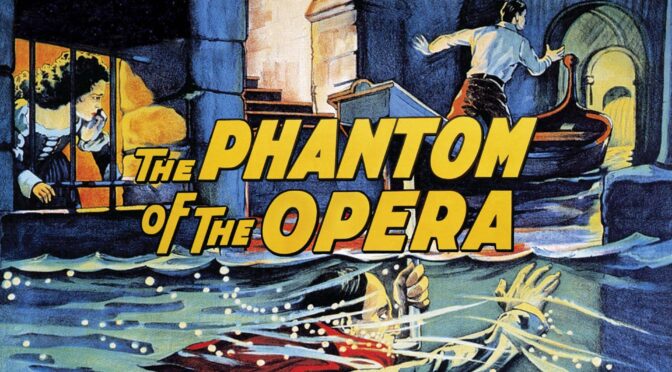The Phantom of the Opera followed Universal’s hit film The Hunchback of Notre Dame (1923), beginning a tradition at the studio of making monster movies. Both films starred Lon Chaney, “the man of a thousand faces” who was largely responsible for their success. Carl Laemmle, President of Universal Pictures, wanted Phantom to be a grand film and a big hit as like Hunchback. And as with Hunchback, Phantom was based on a French Gothic Novel – Gaston Leroux’s Le Fantôme de l’Opéra.

This Blog Post is part of the Classic Movie Blog Association’s Early Shadows & Pre-Code Horror Blogathon
The featured opera house was the Palais Garnier in Paris, built over the years from 1861-1875 and now considered a masterpiece. To replicate its features and its Grand Staircase for the film, Laemmle had the new Stage 28 built on the studio backlot. It was Universal’s first steel and concrete-built stage, measuring 360 feet long by 145 feet wide. But it was not long enough. “For the long shots, we had to take the camera out of the stage and halfway up the hill,” recalled Phantom director of photography, Charles Van Enger. Several scenes were shot in Process 2 Technicolor and Prizma Color. To replicate the look of the Palais Garnier, eleven sculptors and artists worked six weeks creating the sculptures and interior decorations, including a full-sized copy of the statue of Apollo that stands on the roof of the Opera Garnier.
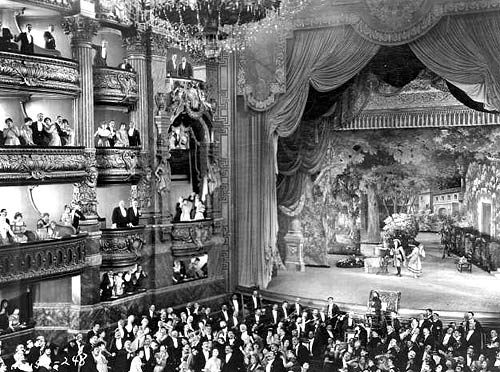
No costume design credit is given, but the Moving Picture World magazine reported that “Universal Pictures sent wardrobe ‘expert’ Charles Le Clerc to France and Germany to ‘search out and buy up’ costumes that had been used in Charles Gounod’s opera, Faust during the 1890s, in order to ensure authenticity ‘to the last detail.’” Le Clerc appears to have been a French actor in the 1920s. Similarly, scouts were sent to Europe to look for “Fin de siècle furnishings and operatic props.” One amazing European prop was found right in Hollywood – the Phantom’s boat bed – custom made in France for the famous entertainer Gaby Deslys and dubbed Cupid’s Boat Bed. It was bought at auction in France for the Rex Ingram film Trifling Women, and later appeared in Daughters of the Rich. After Phantom, it reappeared in Carole Lombard’s movie Twentieth Century, before starring again as Gloria Swanson’s/Norma Desmond’s bed in Sunset Blvd.*
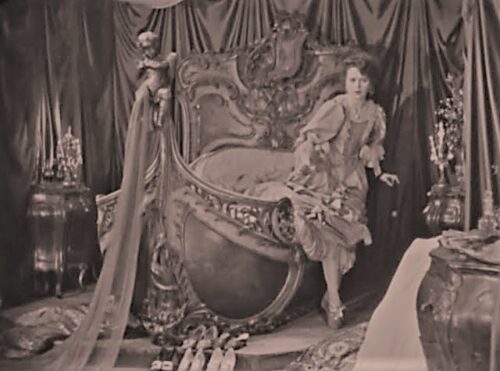
The undisputed star of Phantom is Lon Chaney. In the original novel, the Phantom Erik is described as deformed. Lon Chaney devised his own makeup for all his film outcast characters, including for this one. “I’d worked with Lon for years experimenting with one make-up after another,’ recalled cameraman Virgil Miller, who had photographed Chaney in several pictures prior to Phantom, and who would subsequently handle retakes on the production. ‘He’d say, ‘Virg, make me look frightening and repulsive, but at the same time make the audience love me.’ He always wanted to be loved.”** Lon Chaney knew how to make himself look repulsive in the “prehistoric” days in the art of movie makeup. He made up his own compositions and tools which he carried in a kit that he kept to himself. But his creativity came in all forms. “I achieved the Death’s head of that role without wearing a mask. It was the use of paints in the right shades and the right places — not the obvious parts of the face — which gave the complete illusion of horror. My experiments as a stage manager, which were wide and varied before I jumped into films, taught me much about lighting effects on the actor’s face and the minor tricks of deception. It’s all a matter of combining paints and lights to form the right illusion.” ***
Lon Chaney the person had his own need to feel loved. Both of his parents were deaf and did not speak. They communicated through sign language and facial expressions. Chaney did not learn to speak until after he was two years old, being raised by speechless parents, and even his mother lost the use of her hands from severe arthritis by the time he was nine. Most of Chaney’s best roles were of characters with physical deformities searching for love, including The Unknown, He Who Gets Slapped, The Hunchback, and The Phantom. The Phantom of the Opera was a perfect role for Chaney, one where he is a talented musician and self-appointed mentor to a young singer named Christine Daae, played by Mary Philbin. He manages to have the prima donna Carlota become sick so that Christine can sing in lieu of Carlotta in the role of “Marguerite,” in Faust, where she becomes a success. He further derails Carlota’s career by causing a disaster in the opera. He speaks to Christine from behind the walls of the Opera House and says she can visit him by coming through the mirror where she finds the Phantom wearing a mask to hide his face. “You – you are the Phantom,” she says. “If I am the Phantom, it is because man’s hatred has made me so,” he answers. He leads her, she mounted on a horse, down several subterranean layers, to an underground lake. They go on a small boat that he guides to the entrance of his dwellings, where she realizes she is trapped in his lair. She faints and the Phantom carries her to his bedroom, lined in silk and surrounded by candelabra, where he deposits her on the Boat Bed. He is playing his organ when Christine, unable to control her curiosity, rips of his mask and recoils in horror. If she gives up her fiancé Raoul and comes back to him, he will let her go, which she agrees to do.
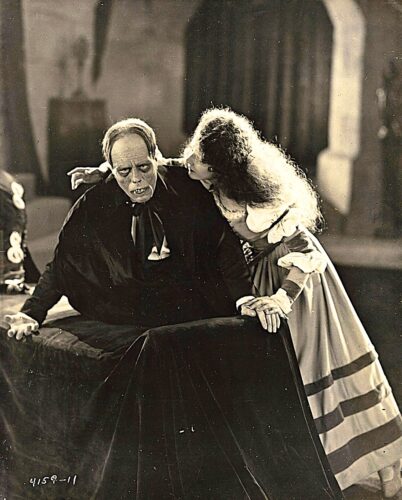
The Bal Masqué is the biggest annual event for the Opéra, where all come dressed with masks, costumes and disguises. The Phantom comes also, dressed as the Red Death, and he is not happy to see Christine and Raoul together again, especially when he overhears them make plans to run away.
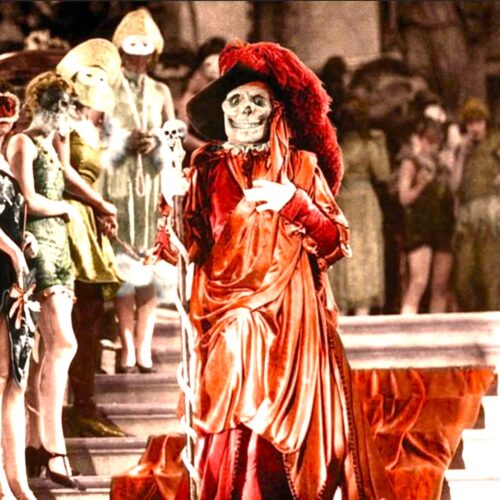
The Phantom of the Opera, like many great films, had a troubled production. Director Rupert Julian had been an actor and was now a dictator. Nobody got along with him, least of all Lon Chaney, who refused to speak with him after the start of production. At one point Chaney himself was directing the film. After the film wrapped, it was screened for a test audience, and Laemmle was not pleased with the film. Story conferences were held and scripts changed. A new director, the comedy director Edward Sedgwick, was hired to lighten the story. Another test screening received worse reviews than the first and all the changes to the film were removed. One original scene that was changed in subsequent versions is where the Phantom died playing his organ – it seemed the public wanted a dramatic revenge.
The final success of The Phantom of the Opera set Universal on a track of specializing in famous monster movies such as Dracula, Frankenstein, The Wolfman, and others. Phantom itself was remade by Universal in 1943, and by other studios and for television – at least six times, not counting the famous Andrew Lloyd Webber opera version that began in London and ran on Broadway for decades. The basic story is related to countless Beauty and the Beast tales from time immemorial.

* https://silverscreenmodes.com/a-boat-bed-prop-featured-in-seven-movies-now-with-unknown/
** Scott MacQueen, The Phantom of the Opera: A Silent-Era Masterpiece, American Cinematographer, October 15, 2023.
*** Benjamin McVay, The Making of The Phantom of the Opera (1925), Cinema Scholars, October 2, 2021. https://cinemascholars.com/the-making-of-the-phantom-of-the-opera-1925/
This Blog Post is part of the Classic Movie Blog Association’s Early Shadows & Pre-Code Horror Blogathon
Read more about many great films at the film reviews above.
Views: 2

